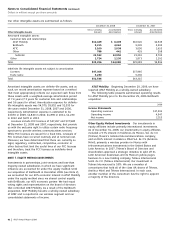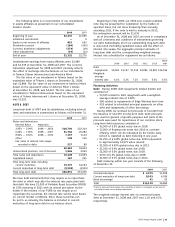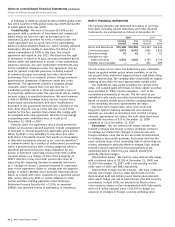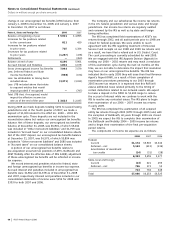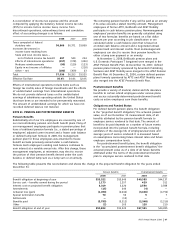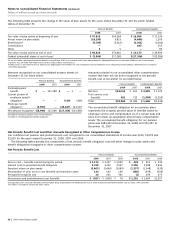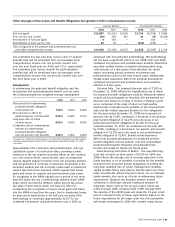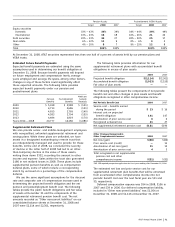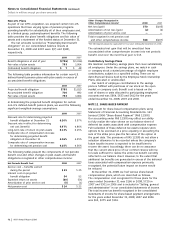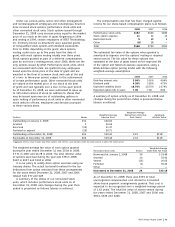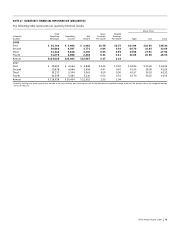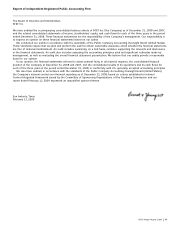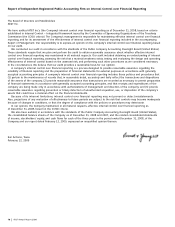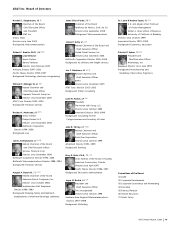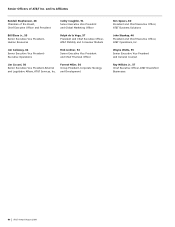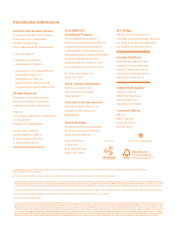AT&T Wireless 2008 Annual Report Download - page 74
Download and view the complete annual report
Please find page 74 of the 2008 AT&T Wireless annual report below. You can navigate through the pages in the report by either clicking on the pages listed below, or by using the keyword search tool below to find specific information within the annual report.
72
| AT&T Annual Report 2008
Notes to Consolidated Financial Statements (continued)
Dollars in millions except per share amounts
Non-U.S. Plans
As part of our ATTC acquisition, we acquired certain non-U.S.
operations that have varying types of pension programs
providing benefits for substantially all of their employees and,
to a limited group, postemployment benefits. The following
table provides the plans’ benefit obligations and fair value of
assets and a statement of the funded status at December 31.
The net amounts recorded as “Postemployment benefit
obligation” on our consolidated balance sheets at
December 31, 2008 and 2007 were $(7) and $(48),
respectively.
2008 2007
Benefit obligations at end of year $(786) $(1,016)
Fair value of plan assets 793 1,064
(Unfunded) benefit obligation $ 7 $ 48
The following table provides information for certain non-U.S.
defined-benefit pension plans with plan assets in excess of
accumulated benefit obligations:
2008 2007
Projected benefit obligation $785 $1,015
Accumulated benefit obligation 700 892
Fair value of plan assets 793 1,064
In determining the projected benefit obligation for certain
non-U.S. defined-benefit pension plans, we used the following
significant weighted-average assumptions:
2008 2007
Discount rate for determining projected
benefit obligation at December 31 6.20% 5.57%
Discount rate in effect for determining
net cost (benefit) 5.57% 4.86%
Long-term rate of return on plan assets 6.13% 6.15%
Composite rate of compensation increase
for determining projected benefit
obligation at December 31 4.06% 4.25%
Composite rate of compensation increase
for determining net pension cost 4.25% 4.36%
The following tables present the components of net periodic
benefit cost and other changes in plan assets and benefit
obligations recognized in other comprehensive income:
Net Periodic Benefit Cost 2008 2007
Service cost – benefits earned
during the period $ 25 $ 25
Interest cost on projected
benefit obligation 54 52
Expected return on assets (60) (54)
Amortization of prior service cost (5) (1)
Net pension cost $ 14 $ 22
Other Changes Recognized in
Other Comprehensive Income1 2008 2007
Net loss (gain) $70 $(105)
Amortization of net loss (gain) (2) (2)
Amortization of prior service cost — —
Total recognized in net pension cost
and other comprehensive income $68 $(107)
1FAS 158 required prospective application for fiscal years ending after December 15, 2006.
The estimated net gain that will be amortized from
accumulated other comprehensive income into net periodic
benefit cost over the next fiscal year is $13.
Contributory Savings Plans
We maintain contributory savings plans that cover substantially
all employees. Under the savings plans, we match in cash
or company stock a stated percentage of eligible employee
contributions, subject to a specified ceiling. There are no
debt-financed shares held by the Employee Stock Ownership
Plans, allocated or unallocated.
Our match of employee contributions to the savings
plans is fulfilled with purchases of our stock on the open
market or company cash. Benefit cost is based on the
cost of shares or units allocated to participating employees’
accounts and was $664, $633 and $412 for the years
ended December31,2008, 2007 and 2006.
NOTE 12. SHARE-BASED PAYMENT
We account for share-based compensation plans using
Statement of Financial Accounting Standards No. 123
(revised 2004) “Share-Based Payment” (FAS 123(R)).
Our accounting under FAS123(R) may affect our ability
to fully realize the value shown on our balance sheet of
deferred tax assets associated with compensation expense.
Full realization of these deferred tax assets requires stock
options to be exercised at a price equaling or exceeding the
sum of the strike price plus the fair value of the option at
the grant date. The provisions of FAS123(R) do not allow a
valuation allowance to be recorded unless the company’s
future taxable income is expected to be insufficient to
recover the asset. Accordingly, there can be no assurance
that the current stock price of our common shares will rise
to levels sufficient to realize the entire tax benefit currently
reflected in our balance sheet. However, to the extent that
additional tax benefits are generated in excess of the deferred
taxes associated with compensation expense previously
recognized, the potential future impact on income would
be reduced.
At December 31, 2008, we had various share-based
compensation plans, which are described as follows.
The compensation cost recognized for those plans for the
years ended December 31 was $166 in 2008, $720 in
2007 and $301 in 2006 and is included in “Selling, general
and administrative” in our consolidated statements of income.
The total income tax benefit recognized in the consolidated
statements of income for share-based payment arrangements
for the years ended December 31, 2008, 2007 and 2006
was $63, $275 and $116.


